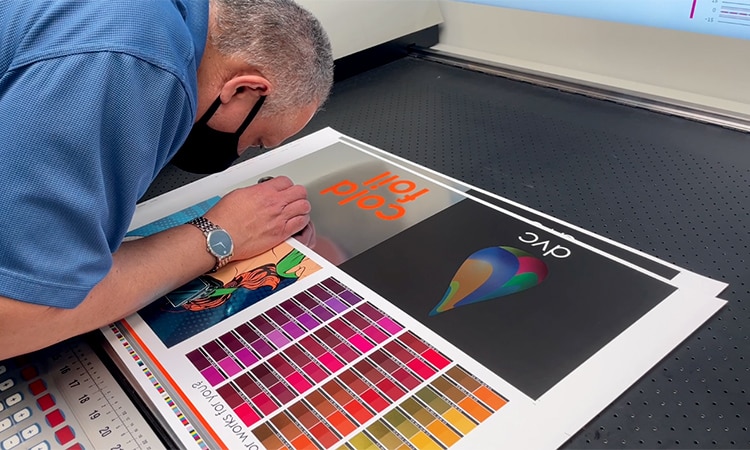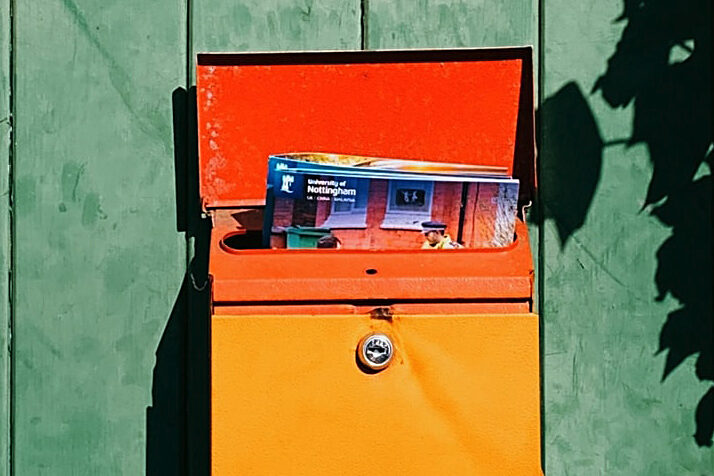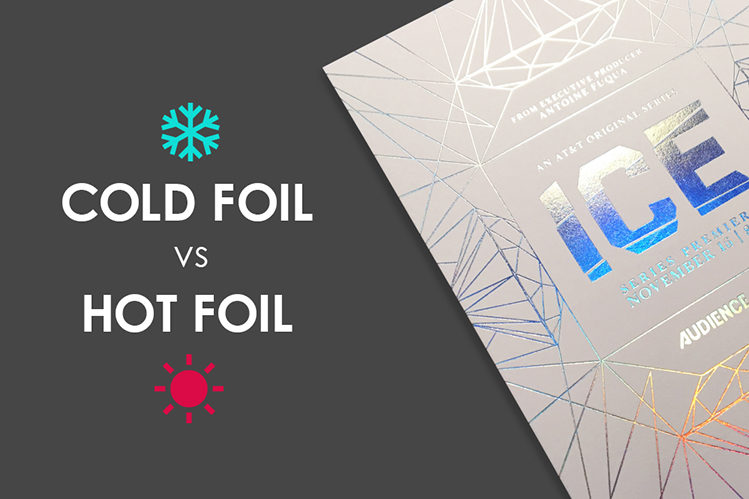
Lithography is often associated with the world of fine art, yet its uses extend far beyond that. With a long and storied history, the unique graphics and superb color quality of lithograph printing remain at the heart of graphic design and the printing industry as a whole. Lithograph printing is used by artists, organizations and regular people worldwide to promote brands, art, events and more!
Understanding what is a lithograph, where it came from, and how the process works today is essential for creating compelling materials with a look no other form of printing can offer.
What is a Lithograph?
A lithograph is a piece of art that involves drawing an image onto a plate. These plates can be made from several materials, but the most common is a piece of limestone or metal. Depending on the method used, original lithograph art is created by treating the hand-drawn image with a special solution. The image is then transferred to paper and can be used and reused multiple times. This method has evolved from hand drawing on limestone to the revolution of industrial printing. Starting from humble beginnings, lithograph printing is now one of the most efficient ways to produce large batches of printed materials. Before we get into the history of the lithograph, we want to address a common point of confusion: lithographs vs. prints.
What is the Difference Between a Lithograph and a Print?
Contrary to popular belief, a lithograph print is not a print in the traditional sense. So, what is lithography and how does it differ from traditional prints? A lithograph is a type of print created through the lithographic process, where an image is drawn or etched onto a flat surface and then printed onto paper, resulting in high-quality reproductions known for their fine details. A “print” is a broader term referring to reproductions of original artworks or images created through various techniques.
Because the steep prices of original artwork and lithographs tend to be out of reach for most of us, it’s not uncommon for original lithography art to be converted into prints for distribution. This is where offset lithograph printing steps up, giving people access to artwork that looks just like the originals (more on this process later).
So how can you tell the difference between an original lithograph vs. print versions?
- Discoloration – Search for the tell-tale signs of chemical oxidation and imperfections in an area where there is no image. Discoloration happens when printing plates aren’t maintained, leading to small markings and imperfections.
- Rows of Dots – An offset print or lithograph poster print will always contain rows of dots on the image. While they’re not obvious, these can be seen up close. In contrast, a lithograph will contain dots patterned randomly throughout the image itself. Moreover, you cannot see these dots on a lithograph without a magnifying glass.
- Signature – Everyone knows original pieces of artwork have the artist’s signature somewhere on the piece. Because lithographs are original pieces of art, you should be able to see the artist’s signature, usually located on the back. Print versions of lithographs typically won’t have an original signature. However, there are limited edition prints that include an artist’s signature.
- Ink Thickness – You can also compare a lithograph vs. print by touch. Rub your hand lightly over an original lithograph, and the surface should feel slightly raised. Prints will always have a completely flat surface because they came from a printing press.
The History of Lithography
Lithography is a German invention brought to life in 1796. It was invented by little-known playwright Alois Senefelder. After writing his scripts in greasy crayon on limestone, he accidentally discovered the process. He quickly and cheaply created duplicates of his scripts by using rolled-on ink.
The discovery soon spread throughout Europe, and it became one of the most popular modern mass printing methods. Portrait artists and illustrators in the popular press would use it for economic reasons. Eventually, the process would be used for nearly all methods of mass printing.
Romanticist painters like Eugène Delacroix and Théodore Géricault would explore the artistic styles inherent in lithography. The dramatic effects created by black chalk or charcoal would come to define the art world for over a century.
Originally, lithography was held back by the fact the color lithograph had yet to be invented. When printing technology improved, lithographic art would be used within the advertising industry of the 1880s and 1890s to create the historic pieces that remain collector’s items today.
Types of Lithograph Printing through History
The original lithographs of the 18th and 19th centuries required heavy limestone slabs. Today, printers often use a prepared metal plate, such as aluminum or zinc. Throughout history, there have been several versions of lithography that all lead to a more advanced version. Each method was unique, although as you’ll see, some stand out as clear winners in terms of quality and quantity.
Here is the progression of lithography over the centuries.
Original Stone Lithography
The oldest type of lithography is the stone lithograph. These lithographs were created by way of a waxy medium applied to a piece of limestone. The grease repelled water, and the lithographer used this concept to apply ink from the limestone to the paper.
The original stone lithograph represents a significant part of our history and a major technological advancement for that time. However, this version is rarely seen today. Due to the mastery required to create an original stone lithograph, these are the most expensive and time-consuming forms of lithography today.
When the medium was created, original stone lithography was the defining mark of Bohemian Paris in the latter decades of the 19th century. It was used to create artwork and advertisements, many of which are now collector’s items worth thousands of dollars. During World War One, the German expressionist movement would use original stone lithography to capture the pain and suffering of the First World War.
Original Plate Lithography
Original plate lithography was the next advancement in lithograph printing. Eventually, printers started having trouble sourcing enough limestone for the industry. Demand outpaced supply during the first century of limestone lithography, leading to costs soaring again. In addition, hard-pressed printers were looking for a way around the time-consuming process of creating a lithograph with a piece of limestone. As a result, the print industry was revolutionized by original plate lithography.
A plate lithograph used aluminum rather than limestone because metal plates were easier to create and operate, giving lithographers more control over the process. Not to mention, it was easier to source aluminum than limestone during that time. The actual method used to create a piece of artwork using original plate lithography never changed, just the medium. Later lithographers would also bring in zinc plates as an alternative to lightweight aluminum.
Lithographic Reproductions
What made an original lithograph so highly prized is that it offered consumers a piece of original artwork. The artist drew these images directly onto the stone or plate that would then be used to create the finished lithograph. As the industrial revolution exploded throughout the world, printers started looking for new and more efficient ways to satisfy the needs of their market. Enter: lithographic reproductions.
The main advancement in lithographic reproductions is that they were no longer required to be done by hand. A lithographic reproduction is a simple copy of an original lithograph or work of art. It could be a photograph taken of the original piece or a print version of the original. These images were mere reproductions, enabling early printers to print in large batches. Lithographic reproductions were used heavily throughout the 19th and early 20th-century printing industries, and are still in use today. Perhaps the most prominent example of the lithograph poster is the series of psychedelic images that appeared in the 1960s.
Offset Lithography
Today, offset lithograph printing is the leading method in use. Printers now use offset lithograph printing on an industrial scale or for printing larger quantities such as magazines, books, newspapers, and more. But how can this method yield such a high quantity at such a high quality? Let’s take a closer look at the offset lithograph print process.
If you took high school chemistry, you already know oil and water don’t mix. This is the concept that offset lithograph printing is based on. Images are transferred onto metal plates to make an impression, which are then dampened by water and pressed with ink rollers. The ink and water don’t mix because the ink (which is oil-based) transfers to the impression of the image, while the water adheres to the area around the image. The ink is then transferred to a rubber component (imagine a huge stamp), which is then pressed onto paper. Offset lithography got its name because the image itself isn’t pressed from the metal plate directly to the paper, it is “offset” to another surface, with the rubber cylinder acting as an intermediary.
The Benefits of Offset Lithograph Printing
Lithograph printing has come a long way since the 1700s when it was accidentally discovered. Offset lithography is now the most used printing method for anyone who wants to print high-quality materials with unrivaled color quality.
So what’s the big deal about this type of printing? Offset lithograph printing is cost-effective for mass production, offers exceptional print quality, can be printed on a wide variety of stock, and excels in color quality and consistency.
In fact, offset litho capabilities include spot (PANTONE) colors, which are standardized and help to ensure consistency across print batches. These colors are standardized internationally, ensuring accurate depictions of original pieces for artists and consistent branding for companies who rely on printed materials. For example, a company letterhead printed on the same paper in Red032U will be the same red in China and the US.
What are some other advantages of offset lithograph printing?
- Clarity – The sharp lines and crisp images produced by offset lithography are practically unrivaled by any other form of printing.
- No Impressions – Offset lithographs rarely contain the marks and impressions found within other printing processes.
- Speed – Today’s web-press printing machines can produce up to 50,000 lithographs per hour.
- Affordability – Offset lithographs are extremely cost-effective to print on a commercial level.
- Versatility – A wide range of presses exist to conform to any print run length.
No other form of printing has been able to replicate the one-of-a-kind look only the lithograph can provide and it continues to be used today. Offset lithograph printing offers modern businesses fast, easy and cost-effective ways to ensure quality materials in bulk.
The uses of offset lithograph printing today are endless, but common uses include (but are certainly not limited to):
- Books
- Magazines
- Menus
- Direct Mail
- Posters
- Door hangers
- Brochures
- Manuals
- Handbooks
- And much more!
If you need sharp and vibrant materials printed in bulk, offset lithography is for you. This printing method is incredibly versatile and can be used for a variety of purposes, whether you’re a business owner looking to promote your brand or an artist promoting your work.
Quality Solutions for Your Printing Needs
When it comes to print quality and color, litho printing can’t be beaten. At D’Andrea Visual Communications, we value the history of the lithograph, which is why we combine the “old” with the “new” for a truly unique and unrivaled printing process. Whether you need custom packaging solutions or promotional materials like catalogs or brochures, D’Andrea Visual Communications can produce crisp, high-quality lithographic prints for your brand.


